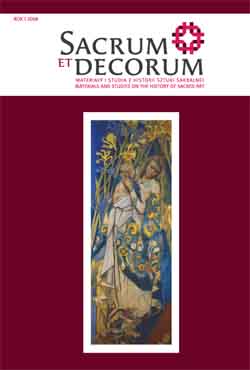Teologia, Biblia i liturgia jako źródła sztuki chrześcijańskiej
Theology, Bible and liturgy as the sources of Christian art
Author(s): Henryk Nadrowski Subject(s): Cultural history
Published by: Wydawnictwo Uniwersytetu Rzeszowskiego
Keywords: theology; the Bible; liturgy; Christian identity; personalism; space-time; architecture; sculpture; reification and hominization of art; iconography; iconology; saeculum; sacrum; the profane; Letter to Artists by Pope John Paul II
Summary/Abstract: It is important, and even essential, to realize that both in the creative and in the perceptive process associated with Christianity one must have the minimum knowledge of theology, the Bible, liturgy, tradition, custom and a general idea of culture and art. Religious art as well as art made for a gallery or museum has a very open character and can even assume the form of an experiment. However, sacred art, which is associated with the space of the church, is an entirely different phenomenon. The latter must have an ancillary and adaptive character: it must serve the community and the individual discovering of the closeness of God, especially during the liturgy. Time, space and man form a kind of triad, which clarifies sacred art. It is a mistake to build churches without a clear indication of that hic et nunc. Space-time, i.e. realization and concretization, allows not only for considering the time of a given epoch but also for creation and evaluation according to its criteria. The subject matter itself does not prejudge the sacred nature and purpose of a given work of art. What is necessary is deliberate and purposeful creative activity, and an object of worship should be carefully designed. However, it must not carry a message that is accidental, incoherent, chaotic. It is necessary to restore the idea of the iconographic programme of a sacred object, which will be anchored to the three foundations listed in the title. These, in turn, will guard the dogmatic correctness of a work of art and clearly explain its sense that results from a consistent iconological message. It is an important task to properly prepare developers, investors, and the faithful-recipients both for the understanding of historical church monuments and for new solutions concerning content and form. However, it is not enough that this space should be correct and functional in its technical or artistic aspect. There is no place for the reification of art. What is important is that the works of sacred art should be imbued with a certain metaphysical depth, a meditative climate or a mystical nature. They should even stimulate a person to meet God. This interpersonal character is crucial: the man-artist establishes a relationship with God in the creative process while and the man-recipient ought to feel this personal relationship with God, which indirectly is also a meeting with the artist. The latter has the role of a priest and prophet, or evangelizer, who is an intermediary leading to the supernatural reality. Moreover, a work of art becomes a meeting place for other people, sometimes even for generations. This is because the spirit of faith and devotion accumulates in it, and the work thus receives a “new life” that transcends not only its time but also the creative idea of the artist. An artist always expresses himself in some way. At the same time, the author of a work of sacred art does not speak in isolation from his specific environment and circumstances. He does no
Journal: Sacrum et Decorum. Materiały i studia z historii sztuki sakralnej
- Issue Year: 2008
- Issue No: 1
- Page Range: 21-46
- Page Count: 25
- Language: Polish

